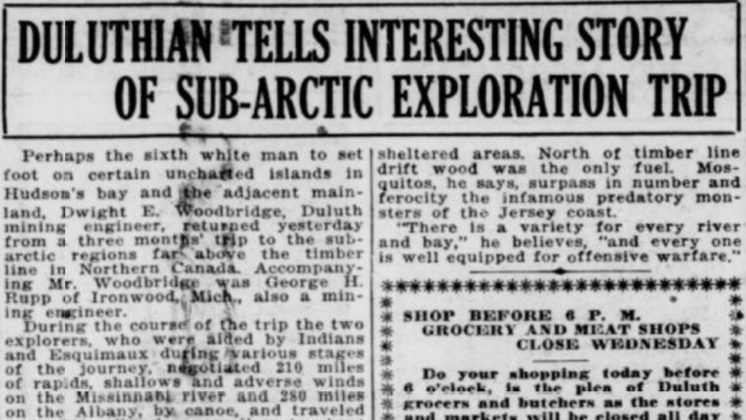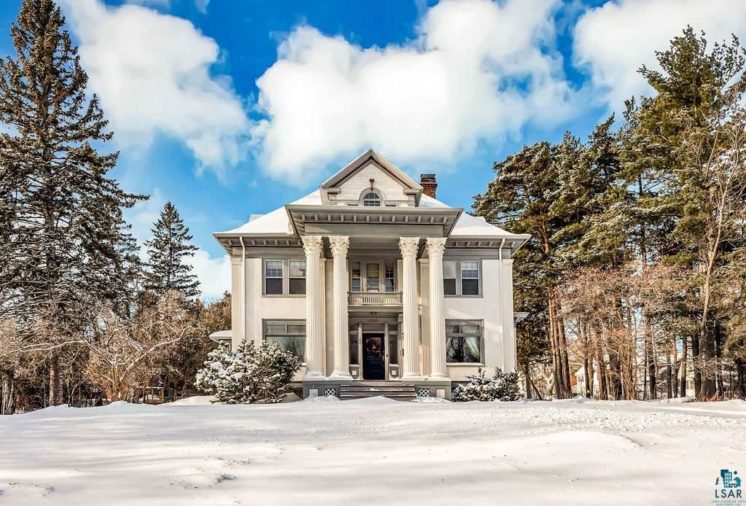Dwight Woodbridge’s 1920 Sub-Arctic Exploration
One century ago, Duluth’s Dwight Woodbridge returned from a trip exploring “uncharted islands” in Hudson Bay in northeastern Canada. His story appears in the Aug. 10, 1920 Duluth Herald.
Duluthian tells interesting story of sub-Arctic exploration trip
Perhaps the sixth white man to set foot on certain uncharted islands in Hudson’s bay and the adjacent mainland, Dwight E. Woodbridgre, Duluth mining engineer, returned yesterday from a three months’ trip to the subarctic regions far above the timber line in Northern Canada. Accompanying Mr. Woodbridge was George H. Kupp of Ironwood, Mich., also a mining engineer.
During the course of the trip the two explorers, who were aided by Indians and Esquimaux during various stages of the journey, negotiated 210 miles of rapids, shallows and adverse winds on the Missinnabi river and 280 miles on the Albany, by canoe, and traveled some 900 miles in a small motor boat on Hudson’s bay. They saw a waterfall — Nastapoka — higher than Niagara and over which an equal volume of water pours. They saw a deep fresh water lake on one of the bay’s uncharted islands, which was forty-five miles long and about 150 square miles in area, and which, although the island was surrounded by the salt water of the bay, was constantly kept fresh from some unknown source.
Fast Canoe Trip.
Incidentally the two explorers made the 280 miles down the Albany river in fifty-six hours elapsed time, gliding rapidly through dense forests of spruce almost all the way. The engineers were making a study of mineral bearing formations, which Mr. Woodbridge says are promising and very important, but will be out of reach of civilization until better communication is established. This may be shortly.
Of his trip Mr. Woodbridge says in part:
“We left the Transcontinental railroad north of Toronto and embarked in a canoe, in which we paddled down the Albany river to the fort of the same name. We made the trip of 280 miles in fifty-six hours elapsed time. In contrast to this speedy journey it took us ten days to negotiate 210 miles of rapids and shallows against adverse winds coming up the Missinnabi. We were at Fort Albany, a Hudson’s bay post, during the company’s celebration of its two hundred and fiftieth birthday anniversary. Indians were gathered in athletic contests and various games. During the course of our trip we visited several other posts of the fur company, notably Moose factory, Fort George, the latter in the Ungava country. Coincidentally with our arrival, July 19, the first mail to reach the post since Nov. 1 was delivered from a steamer, and it
was the only steamer we saw during our travels.Tells of Esquimaux.
“I cannot understand why Hudson’s bay should be so named. It is a regular ocean, 1,200 miles long and 700 across. When we got beyond timber line we met many Esquimaux who live north of the Indian country and who never mingle with the Indians.
“We were very much impressed with the friendliness, happiness and patience of the Esquimaux, in marked contrast with the generally known attitude of Indians. Their penchant for handshaking would do credit to a politician. Every one in our party had to shake hands with every Esquimaux, and if one were missed he quickly made the oversight known. The Esquimaux live in a constant state of semi-starvatlon. Those we met subsisted chiefly on fish and seal meat, usually eaten raw. The great caribou herds have left the region long since, for pastures farther to the west, where I was told they still roam in countless numbers.
“In summer the Esquimaux live in ‘topicks,’ or wigwams, made of sealskin. In winter they llve in snow huts. The largest village we visited consisted of twenty-three topicks, some large enough for the accommodation of several families. All Esquimaux love tobacco and tea and were grateful for presents of those commodities. They wear clothing of sealskln, and in some cases the breasts of ducks, grebes and similar birds.
Long Journey in Small Boat.
“We journeyed some 900 miles along the uncharted and rocky coast of Hudson’s bay in a forty-foot motor boat. I was particularly interested in a group of islands which appear on the map as merely a few dots, but one group of which in reality comprises an area of 4,000 square miles. These Islands have been covered with a recent flow of lava and there is a resultant peculiarity of rock formation, appearing like a series of boulders cemented by the lava. In some instances the evidences of glacial action are very distinct and numerous.
“It was on one of the islands that we saw the big fresh water lake. There is a continuous flow of fresh water, although the nearest land from which fresh water could come is seventy-five miles away. There are no visible inlets. Some of these islands are inhabited by Esquimaux.”
Although it was during the “warm” season when the party left for home, Mr. Woodbridge says there was much ice in the bay and damp salt winds added a touch of winter which was accentuated by the snow which lay in sheltered areas. North of timber line drift wood was the only fuel. Mosquitos, he says, surpass in number and ferocity the infamous predatory monsters of the Jersey coast.
“There is a variety for every river and bay,” he believes, “and every one is well equipped for offensive warfare.”
Dwight Edward Woodbridge died in 1944. His Duluth home at 1735 Wallace Ave. changed hands in February, and looks rather handsome in the Real Living real estate listing.
Recommended Links:
Leave a Comment
Only registered members can post a comment , Login / Register Here
















No Comments